#neme art
Text



i am Very Normal™ about them
(images from March & April)
#neme art#tav!isaac#isaac volkhov#astarion#tav x astarion#will i make more?#idk#neme ocs#gay ppl on my blog (good)
9 notes
·
View notes
Text

honk (Twitter Mirror)

7 notes
·
View notes
Text

Clarel Neme (Uruguayan, 1926-2004) - Jineteada
174 notes
·
View notes
Text

How Hyperion's Shrike would look like as a female.
#ai generated#ai art#shrike#hyperion#Rhadamanth Nemes#hyperion cantos#fooocus#dark aesthetic#dark vibes#darkness#barbed wire#red eyes#monster
8 notes
·
View notes
Text

Artfight attack for @saint-nevermore
13 notes
·
View notes
Text

Night hunter kills nightmare king due to being tired of him
Found deleted episode
#lego#lego dreamzzz#dreamzzz night hunter#dreamzzz nightmare king#meme#lego neme#lego shitpost#fanart#art#found episode leak
9 notes
·
View notes
Photo
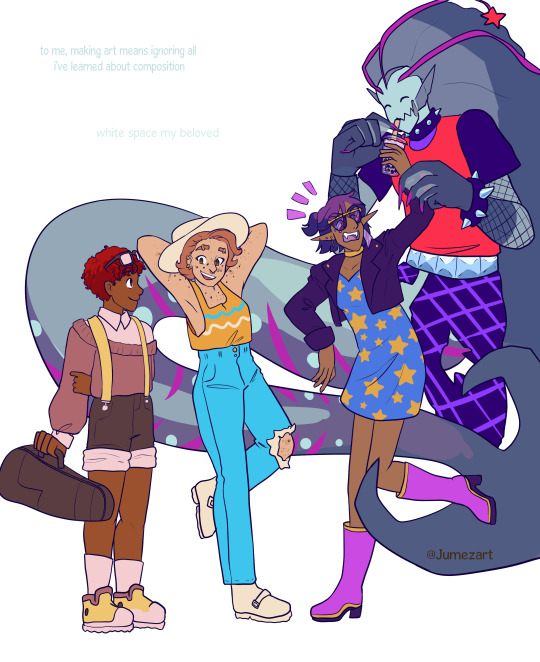
Its the dnd party ( + patron) in snazzy clothes from @hometownrockstar s outfit meme
#Nestor Nemes#Charlene Payne#Zachria Adakias#Airon#Outfit Meme#Art Meme#Gift Art#OC#other peoples OCs#I wanted zach to drink someithing more obscure than taro milk tea but he canonically orders milk and he loves purple so let it be known#modern au zach loves taro milk tea
18 notes
·
View notes
Text
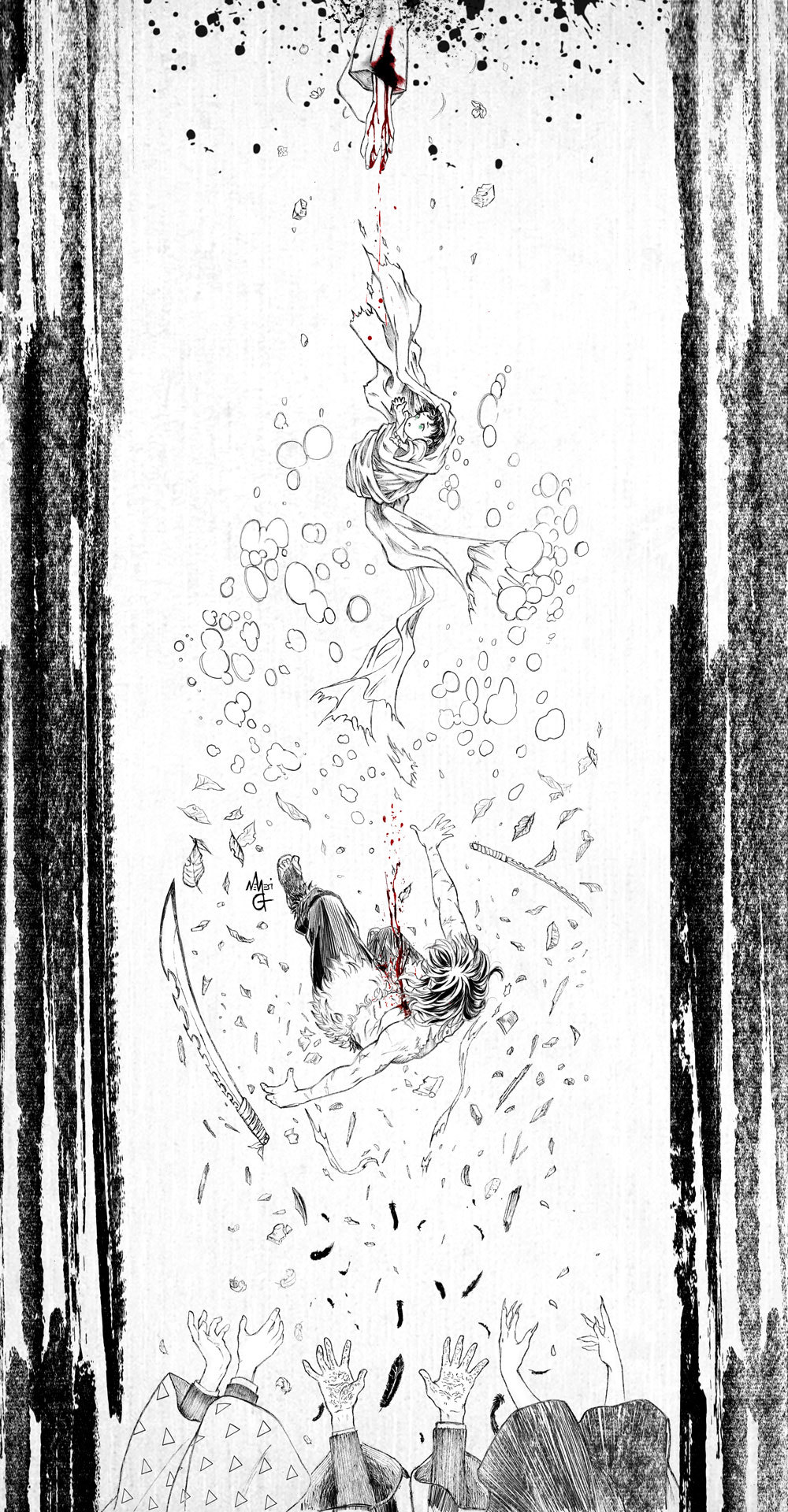
Hi, I'm Neme, and sometimes I exaggerate (lll¬ω¬)
POTENTIAL SPOILERS IN THE ART AND THE DESCRIPTION BELOW!!
Adding a separate post with a video :D
THIS, this was born from a vague idea I had, of drawing Inosuke falling. For some reason, I wanted to draw him from the back - shoulders bare, hair flying everywhere, his face not visible; body straining, bowing, arm outstretched towards... something, way, way up above him, too far away and unreachable. And I did that.
Then I told myself, "let's add Kotoha!"...
Then I said "Why not add baby Inosuke?".
Then I said "let's make the falling section something inspired by his death scene in the Entertainment District Arc!".
Hence the trail of blood.
Then, since Baby Inosuke already had bubbles around him, to represent the river he falls into, I added debris, flowers and grass falling from the cliff where Kotoha dies.
Between Baby Inosuke and Teen Inosuke there are leaves and acorns, to symbolise the Mountain and the woods he grows up in.
Since I'd decided the third scene is the scene where Gyutaro stabbed Inosuke in the heart, I added pieces of roof tiles, broken vases, fabric, splinters of wood... stuff that I guessed could be seen falling as Yoshiwara was destroyed.
Then, since this was already a summary of Ino's (tragic) life, I HAD to add a ray of light at the end/the bottom... The Kamaboko Squad in all its glory.
Between Inosuke and his friends, I added - mainly - feathers. Crow feathers around Tanjiro, Sparrow feathers around Zenitsu and... well, honestly I put sharp, demonic teeth around Nezuko. It felt like the feathers had no direct connection to her, so I had to improvise.
#inosuke hashibira#kotoha hashibira#Demon Slayer#kimetsu no yaiba#kimetsu fanart#Baby Inosuke#tanjiro kamado#nezuko kamado#zenitsu agatsuma#nemeart#tw:blood#kny fanart
572 notes
·
View notes
Text



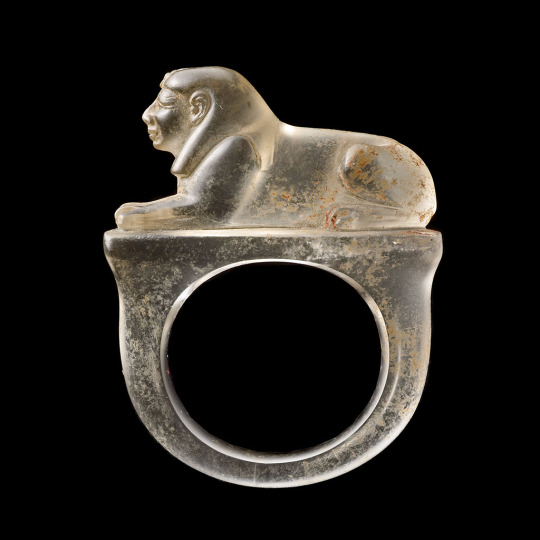
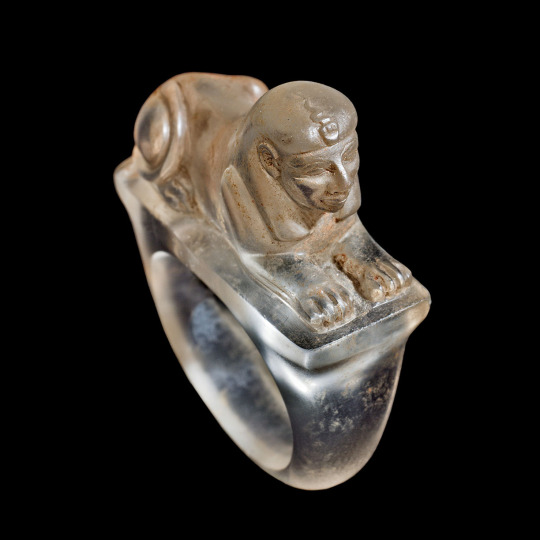
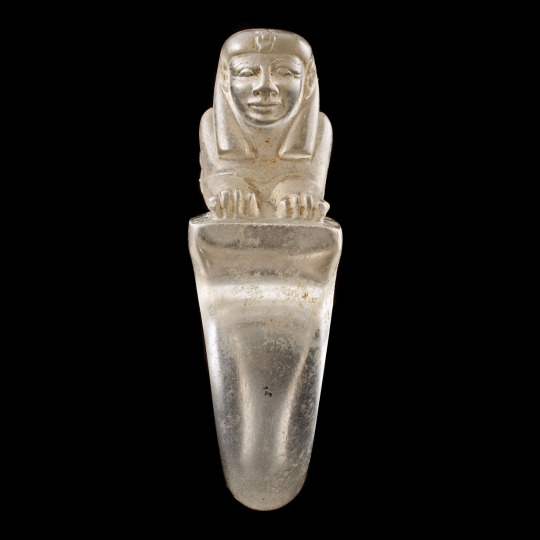
Egyptian Rock Crystal Ring with a Sphinx,
Egyptian · New Kingdom, Ramesside period, IX - XX Dynasty , 1295 - 1069 BC.
The design and execution of the sphinx is masterful. It rests with its tail characteristically following the contour of its right, hind leg, around which it rests.
Like most Egyptian sphinxes, the head of this example is covered by a nemes-headdress, here plain, to the front of which has been affixed a uraeus, or sacred cobra, its tail undulating over its top.
Attention has been paid to the detailed rendering of the toes on the extended front paws. The round face of the sphinx is dominated by large, almond-shaped eyes, set into fairly deep sockets with its eyebrows rendered by incision. The nose exhibits wide wings, its nostrils drilled and prominent. A faint philtrum, or depression, under the center of the nose separates it from the wide, horizontally aligned mouth with its fleshy lips.
The resulting physiognomy gives one the impression of strength and power, devoid as it is of the bland, idealizing features which often characterize the faces of such composite beasts.
That impression contributes significantly to the monumentality inherent in this miniature, jewel-like masterpiece.
Whereas it is difficult to compare the face on our sphinx, despite its inherent monumentality, to much larger examples in stone in order to suggest the identity of the pharaoh represented, its round face and non-idealizing features with their pronounced cheek bones resonate with physiognomic features encountered in some representations of Rameses II.
Rock crystal, perhaps termed menu hedej, in the hieroglyphs was a stone much coveted for amulets and miniature, deluxe vases but its use, because of its rarity, was very restricted.
Rock Crystal, L: 3.2 cm x H: 4.1 cm
Courtesy: Phoenix Ancient Art
#art#history#design#style#archeology#sculpture#antiquity#egypt#sphinx#new kingdom#ring#jewellery#jewelry#rock crystal#XX dynasty#miniature
102 notes
·
View notes
Text
Ancient Egypt and Ostrich Feathers
Have a question for the Egyptologists and knowledgeable fans of Ancient Egypt about ostrich feathers.
(btw is there an Egyptologist Tumblr community? I follow @thatlittleegyptologist but don't know of any other accounts. HMU!)
When I was in Egypt last month I went to the Grand Egyptian Museum to take the very limited tour of the atrium they offer now. It... wasn't worth the money. Anywho, our tour guide did his best to make it seem valuable by talking a LOT about each thing he showed us.
Next to the colossal statue of Ramses II that dominates the atrium there's a table showing the emblems of royal iconography. The sun disk, the nemes headdress, cow horns, and a feather. He asks us if we know what that last one is and I or someone says it's the feather of Ma'at. Correct! Do we know what bird it comes from? The ostrich, someone else says. Why did they choose ostrich feathers for Ma'at and also certain crowns?
On this trip I had gone to the Nubian museum and thus had just seen several pieces of art from pre-historical peoples that utilized ostrich eggs, including a famous one that had three pyramids etched into it along with some animals. So I said something like: The ostrich has been an important animal even before the pharaohs. They relied on it for food and made art with the eggs. The tour guide (Mark) said: That's an awfully materialistic view. No, that's not why.
Now... I know I'm not an expert even though I know a lot about ancient Egypt. But "a materialistic view"? Like somehow it's not enough that ostriches provided food and probably were used in other, important ways? Why do you think Hathor is represented as a cow and there are cow horns incorporated in crowns? Because they look cool? wtf?
Mark then goes on to tell this story. Back in the dawn of civilization in Egypt the Egyptian man didn't have much to do during the day. (eyebrow raise) So he started collecting feathers from all the birds that flew above him in the sky. (...um... wait...) He would collect and then count the barbules and do you know what he discovered? Only the ostrich had the same number of them on both sides. That's why this is the feather of balance and justice.
Friends. I have never wanted to scream SHENANIGANS or at least CITE YOUR SOURCES so much in my life. Like... what?
Leaving aside the implication that ostriches were somehow flying above ancient Egyptians or that there was some point where men didn't have a dang thing to do all day but count the little hairs on feathers, I feel like this explanation is complete hooey. I mean, it could be that all or some of an ostrich's feathers have the same amount of barbules on either side of the middle bit. You might even be able to convince me that this isn't true for any other bird that someone from the Nile valley 6,000+ years ago had access to. But I'm going to need a ton of supporting evidence that this is the sole reason why the feather of Ma'at is an ostrich feather and not for the "materialistic" reasons I cited.
Also, I'm sorry, but I'm real sure predynastic Nile valley dwellers were far more concerned about food and shelter than coming up with complex reasons for using a certain kind of feather to represent a metaphysical thing.
However, I could be wrong! So I'm asking: is there evidence for Mark's version of events? Is this, you know, written somewhere in a papyrus or on a temple wall or another place? I would honestly love to read any papers on this subject, whatever the background on it.
As to the Grand Egyptian Museum, I really hope that whoever they hire to give tours when the whole thing opens are better at this than Mark. I wasn't impressed with his tour overall and eventually gave up listening to him once I saw that there was a gelato place open for business inside.
#Egyptology#Egyptologists#Calling for Egyptologists!#Egypt#Ancient Egypt#I need to know if Mark is right#okay kay what I really want to know is that mark is wrong
322 notes
·
View notes
Text


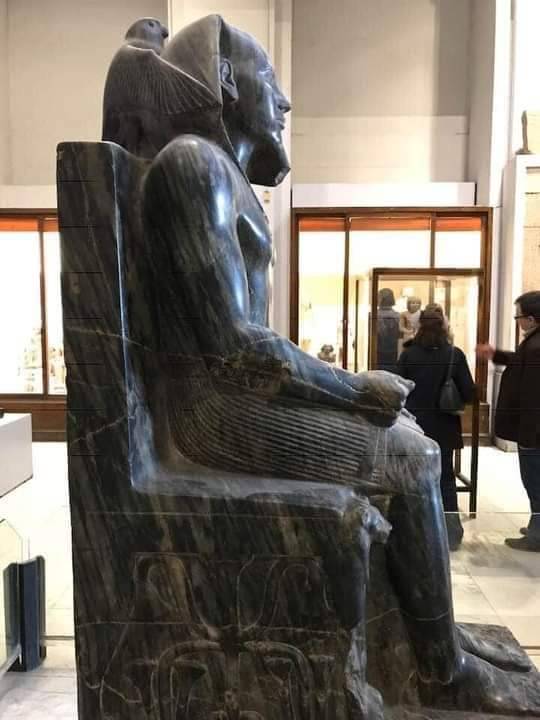

Statue of King Khafre
This statue of "Auguste Marit" was found in his valley temple in Giza. It dates back to the ancient state "Fourth Dynasty".
Let's know who is King Khafre 👇
He is the owner of the second largest pyramid in Giza and it is called the Pyramid of Khafre. He is the son of King Khufu, the owner of the Great Pyramid. He ruled for 25 years and built his funeral group in Giza.
This statue is one of the most prominent pieces of art in the Egyptian Museum. The king appeared seated in an official form on the throne, wearing a nemes hair cover, and adorning his forehead with a royal uraeus for protection, and wearing a royal false beard. He appears wearing a short royal apron.
The king is depicted placing his left hand on his knee and the right hand on the knee as well, but he is held and holding a piece of leopard skin with it. Opinions differ about what he holds in his hand, either a handkerchief or a papyrus, and some believe that it is a legal document of his sitting on the throne. Here the statue appeared through his looks and his body in a position of strength and firmness, and the artist drew a simple smile on his lips, and the artist excelled in showing him the ideal form of the king and the muscles of his body.
Standing behind the head of the falcon King Horus, spreading his wings
On the legs of the throne seat appeared the form of lions for protection, as well as the two sides of the throne, the symbol of unity that appears in the form of a trachea and two lungs, and the papyrus and lotus were linked to them, symbolic of the tribal and marine face. The name of Khafre and his titles such as “Khafre, the master of the crowns” were engraved on the throne’s base.❤️🇪🇬
44 notes
·
View notes
Text

average astarion romance run
#neme art#shitposting#baldur's gate 3#astarion#neme ocs#tav!isaac#isaac volkhov#pov: chaotic good vs neutral evil
8 notes
·
View notes
Text

"YOU'RE GONNA WHAT?????" (Twitter Mirror)
3 notes
·
View notes
Text

Clarel Neme (Uruguayan, 1926-2004) - Dama tejiendo
36 notes
·
View notes
Text

Head of king Senusret III with nemes headdress
Middle Kingdom, 12th Dynasty, ca. 1878-1839 BC.
Now in the Fitzwilliam Museum, Cambridge. E.37.1930
The face of Senusret III is one of the most individual and recognizable in all of Egyptian art. The deep-set, heavy-lidded eyes, the thin lips, and the series of diagonal furrows marking the rather hollow cheeks give representations of this king a brooding expression not usually found on the faces of Egyptian kings, who are generally portrayed with a more youthful countenance.
This image is one of the few instances in Egyptian art in which the ruler seems consciously to have chosen to represent his humanity rather than an idealized image of eternal kingship.
Read more
22 notes
·
View notes
